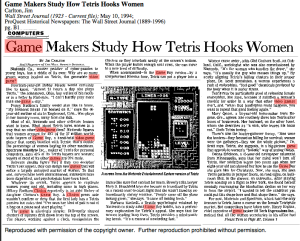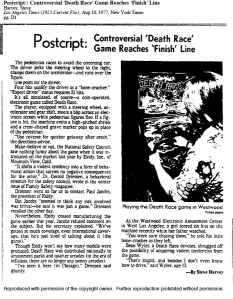Data Visualization of Published Findings on Video Games and Aggression in Children 1984-1995
n = 13
That is, only 13 published studies, specifically on the relationship between video games and aggressive behavior, existed in that time frame. Subjects are mostly children and adolescents, with two studies testing undergraduates.
video games
In the News! Mortal Kombat Video Game Playlist – 1993-1995
VideoCourtesy Mortal Kombat Secrets – MKSecrets.Net
90s CD-ROM Boom! (Notes. Comments, corrections welcome!)
StandardCD-ROM BOOM
The push for mass use of CD-ROM “for the common man” came with the initial installation, and subsequent standardization of CD-ROM drives in the personal computer in the late 1980s. On their own CD-ROM drives were expensive, costing between $600 to $1,200 (roughly $1,130 to $2,260 in 2013).[1] CD-ROM titles were also few and expensive. The first personal computer system that came with installed, low-cost CD-ROM drives were the Headstart LX-CD and Headstart III-CD, made in 1989 by Philips subsidiary, Headstart Technologies Company.[2] They company was able to reduce the price of CD-ROM drives by half. CD-ROM became immediately popular, and by 1990 drives were on backorder by two months with Apple.[3] Other companies, including as Panasonic, Pioneer, Toshiba, IBM, Tandy Corporation, Microsoft (who preferred the term “multimedia”), and Warner New Media, all promised CD-ROM drives as standard features within the coming years, with an expected growth of the CD-ROM market of 40% between 1988 and 1993.[4]
Game Makers Study How Tetris Hooks Women – WSJ 1994
StandardThis morning I read “No Girls Allowed: Unraveling the story behind the stereotype of video games being for boys” by Tracey Lien, Dec. 02, 2013
In the article, Lien discusses a brief history of how games were not, then were made for boys/men over time. I thought it was funny, then, when an hour ago I found this charm of an article in the WSF from 1994, discussing how Tetris was effectively an unintended women-game. The author highlights that creator Alexey Pajitnov admitted, “when I designed the game, I did not have women in mind.” The gendering is just about nauseating.
Jim Carlton, “Game Makers Study How Tetris Hooks Women,” WSJ pg. B1, May 10, 1994
ProQuest Historical Newspapers: The Wall Street Journal (1889-1996)


(apologies for the pink highlights)
Some gold:
“Why are so many grown women hooked on Tetris, the geometric video game? … What about Tetris lures women in a way that no other video game does? Nintendo figures that women account for 40% of the 27 million world-wide buyers of Game Boy, a hand-held video game player that comes bundled with Tetris; that’s double the percentage of women buying its other machines.”
“Hillary Rodham Clinton reportedly is an avid filcher of daughter Chelsea’s Game Boy. A Clinton press aide wouldn’t confirm or deny that the first lady has a Tetris passion but notes that ‘I’ve seen her kind of pull it out of a bag on a plane and start playing.'”
“Women crave order, adds Gini Graham Scott, an Oakland, Calif., sociologist who was also commissioned by Nintendo. ‘It’s the woman who handles the decor,’ she says, ‘It’s usually the guy who messes things up.’ … Tetris may be particularly good at releasing female endorphins, she says, because it satisfies a woman’s craving for order in a way that other video games don’t, and ‘when that [endorphin rush] happens, you want to repeat that good feeling again.'”
“There’s also the hunter-gatherer theory. ‘Men were the hunters- they focused on killing for survival; women were the gatherers- they see the whole picture,’ Dr. Scott says. Tetris, she suggests, is a big-picture game that appeals to women’s ‘holistic’ way of seeing things.”
“Some warn that Tetris addiction among women may bring the same kind of social harm that alarmists have warned could affect children. In a report for Nintendo, Dr. Mackoff, the psychologist, wrote that Game Boy play can result in ‘driven, pleasureless participation that excludes socializing and other creative forms of relaxation.'”
…a curious new psychiatric disorder that the authors terms ‘Space Invaders Obsession’
Standard“The intrusion of video games into health related issues has not been restricted to physical maladies. In September 1982 the Journal of the American Medical Association reported a curious new psychiatric disorder that the authors terms ‘Space Invaders Obsession.’ The victims of this disorder were men about to be married, and it took the form of a fourfold (or greater) increase in the playing of Space Invaders in the few weeks preceding the marriage. One man insisted that the honeymoon be postponed for a few hours so that he could get in a few more games. The authors, researchers at the Duke University medical Center, asserted that the principal goal of the game – defending a home base against aliens – took on a special symbolic significance in the face of an impending marriage. (It also reported that, for whatever reason, gameplaying dropped dramatically following marriage.)
– Excerpt from Mind at Play: the Psychology of Video Games (1983) by Geoffrey R. Loftus and Elizabeth F. Loftus, 109
“a player takes the first step to creating violence”
StandardWithin months of its release, Death Race (Exidy, 1976) attracted national attention for its violence. According to cultural historian and assistant professor of Digital Humanities and Media Studies at Illinois Institute of Technology, Carly A. Kocurek, despite the rudimentary graphics of the game, and despite advertisements and verbal assurance from the creators that the icons were monsters and not humans, it was impossible for the general public to dissociate the game from the film, Death Race 2000 (Paul Bartel, 1975). “The story of the film,” Kocurek writes, “became the narrative world of the game.” See The Agony and the Exidy: A History of Video Game Violence and the Legacy of Death Race
And The International Arcade Museum’s page
And the wikipedia
If anyone knows how to get a hold of the 60 Minutes episode, please let me know.
Here are a couple of fun articles.
What do you do now? Ask JOE MONTANA.
StandardLIEBERMAN CALLS FOR PARENTAL WARNINGS ON VIDEO GAMES SENATOR SAYS SOME GAMES PROMOTE VIOLENCE, SEX (1993)
StandardCooper and Mackie, 1986, Video Games and Aggression in Children
StandardCooper, Joel, and Diane Mackie. 1986. “Video Games and Aggression in Children.” Journal of Applied Social Psychology 16 (8): 726-744.
This study examined the effect of playing an aggressive or nonaggressive video game on fifth-graders’ free play. Twenty-two pairs of boys and 20 pairs of girls were randomly assigned to one of three conditions. One of the children in each pair played a video game rated by peers as aggressive, a video game with little aggression, or a non-video maze-solving game for 8 minutes. The other child watched. Each child was then left individually to engage in free play in a separate room for 8 minutes, and also given the opportunity to deliver rewards and punishments to another child. The results were similar for both players and observers. Girls shoed significantly more general activity and aggressive free play after playing the aggressive video game, but they perceived Missle Command as only slightly more violent than Pac-Man. Girls’activity decreased and their quiet play slightly increased after playing the low aggressive game compared to the control group. Differences in boy’s vs. girls’ activity may be a function of socialization in appropriate boy/girl behavior. Neither video game had any significant effect on boys’ free play. Video games did not affect boys’ or girls’ behavior on the intepersonal measure of aggression (ie. neither girls nor boys gave significantly more punishments or rewards after playing any of the games). According to the authors, these results suggest that video game effects are not parallel with violent television effects.





